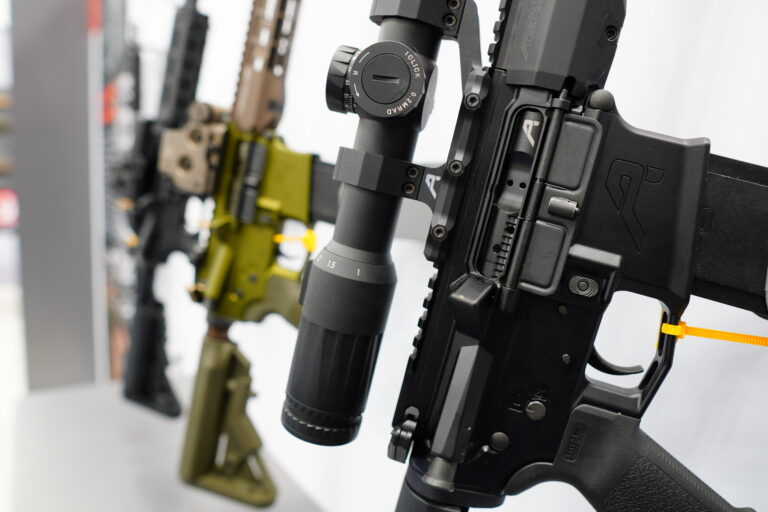A Massachusetts federal judge upheld the commonwealth’s ban on AR-15s and similar rifles this week. His rationale for doing so relied on an idiosyncratic understanding of the rifle’s purported lethality and defensive utility.
On Thursday, U.S. District Judge F. Dennis Saylor IV denied a motion for preliminary injunction against Massachusetts’ ban on “assault weapons” and ammunition magazines capable of holding more than ten rounds. He did so by putting a new twist on an old argument. He determined that modern laws banning AR-15s fit within the country’s historical tradition of regulating “dangerous and unusual” weapons.
“The banned weapons are ‘dangerous,’ because they are unreasonably dangerous for ordinary purposes of self-defense due to their extreme lethality and high potential for collateral harm,” Saylor, a George W. Bush appointee, wrote in Capen v. Campbell, “and they are ‘unusual,’ because it would be unusual for an ordinary citizen to carry such a weapon on his person on the street for self-defense, or to use it in the home to confront invaders or to protect against personal violence.”
While Saylor is certainly not the first to uphold a hardware ban since the Supreme Court’s Bruen decision, his analytical framework for doing so stands out among the rest for its emphasis on the “dangerous and unusual” standard and his understanding of how AR-15s fit in.
Most other judges to date have upheld such bans on the grounds that AR-15s are either not “in common use” for self-defense because of their purported lack of prevalence among spotty statistical records of defensive gun uses or because prohibitions against them fit within a tradition of regulating weapons based on “dramatic technological change and unprecedented societal concerns for public safety.”
In its 2008 District of Columbia v. Heller decision, the Supreme Court set a new floor for hardware bans when it invalidated a total ban on handgun ownership inside the home. In doing so, the Court ruled that the Second Amendment protects arms “typically possessed by law-abiding citizens for lawful purposes.” The Court further clarified the scope of this protection by drawing on the 1939 decision in United States v. Miller, stating, “Miller’s holding that the sorts of weapons protected are those ‘in common use at the time’ finds support in the historical tradition of prohibiting the carrying of dangerous and unusual weapons.”
Subsequent courts have since reviewed legal challenges to bans on certain weapons, most often AR-15s, with this limited guidance from the High Court in mind. In Saylor’s reading of the standard, AR-15s fit the bill because they are “functionally identical” to military M-16s and M-4s–despite only being capable of semi-automatic fire.
“In short, the AR-15 is a weapon with the same basic characteristics, functionality, capabilities, and potential for injury as the standard-issue rifle for infantry troops,” he wrote. “It can be fired in the same way that military forces recommend that it be used for maximum effectiveness.”
However, he noted that the rifle’s similarities to its military-issued counterpart were alone insufficient to prove that it is “dangerous and unusual,” as some other courts have found. Instead, he argued that its “military usefulness” renders it “unreasonably dangerous” compared with other civilian self-defense weapons currently recognized under Second Amendment caselaw, namely handguns.
“Rather, it is the fact that the design and features of an AR-15, compared to a typical handgun, makes it an unreasonably dangerous and unusual weapon for ordinary self-defense purposes,” he wrote. “First, the intrinsic characteristics of assault weapons make them poor self-defense weapons. AR-15s are physically unsuited to typical self-defense scenarios. They are significantly heavier and longer than typical handguns, making them less concealable, more difficult to use, and less readily accessible, particularly for an inexperienced user. They are not generally useful or appropriate weapons for ordinary citizens to keep at their bedsides or to carry on city streets as they go about their daily business.”
He also argued that the high muzzle velocity of typical AR-15 cartridges makes them “unsuitable” for self-defense and more dangerous than “ordinary 9mm handguns” due to over-penetration risks. He suggested that the rifle’s high velocity but relatively low recoil combine to make an AR-15 simultaneously more lethal than both handguns and full-powered centerfire rifles.
“Indeed, a round fired from an AR-15 distributes less than half of the kinetic energy of one fired from a hunting rifle,” he wrote. “In other weapons, the higher kinetic energy is distributed, in part, to the shooter as recoil, which necessarily disrupts follow-on shots. In an AR-15, however, the lower kinetic energy means that rounds fired with a high muzzle velocity can also be fired in rapid succession on a precise target, even while standing or moving because a shooter’s position is relatively unaffected by the recoil of each shot. Less recoil translates into ‘more rounds on target,’ and thus greater lethality.”
Saylor’s analysis of the AR-15’s dangerous and unusual nature is one gun-rights advocates will likely find fault with, but they probably won’t be the only ones. Tens of thousands of police officers in departments all across the country regularly employ AR-15s as patrol rifles for defensive purposes. Similarly, survey data indicates that approximately two-thirds of the estimated 24.6 million AR-15 owners say they own them for exactly that purpose.
Judge Saylor’s distinction between the AR-15’s purported lethality compared with higher-recoiling centerfire rifles also raises interesting legal implications for other semi-automatic long guns typically covered under assault weapon bans.
If the ability to fire low-recoiling, high-velocity intermediate cartridges is what determines if a semi-automatic weapon is “unreasonably dangerous and unusual,” does that mean full-powered semi-automatic rifle platforms like the AR-10 and SCAR 17—which typically fire the same rounds as the generic “hunting rifle” Saylor referenced—are not dangerous and therefore cannot be banned? His legal reasoning, at the very least, raises that possibility.
To be sure, the ruling is just one judge’s opinion at the District Court level. As such, its implications are fairly limited. But until the Supreme Court steps in and fully fleshes out the parameters of its Bruen test on hardware bans—which it has so far proved hesitant to do—gun owners in ban states will continue to face widely differing interpretations on the scope of their Second Amendment rights.







Only Members can view comments. Become a member today to join the conversation.